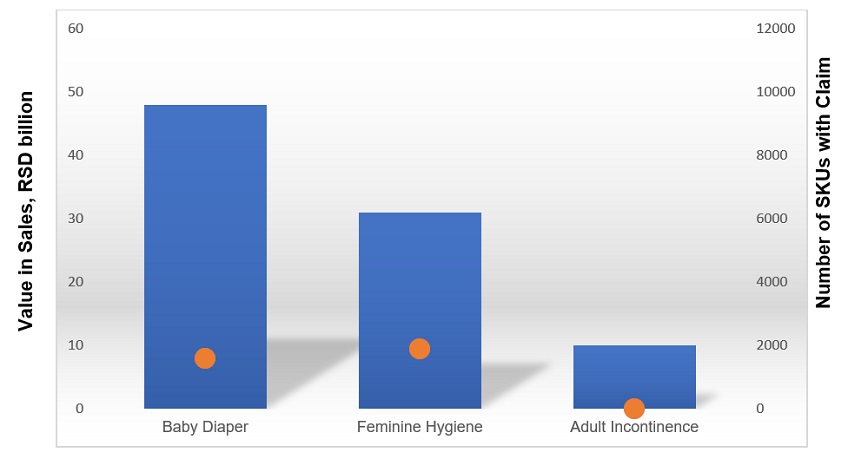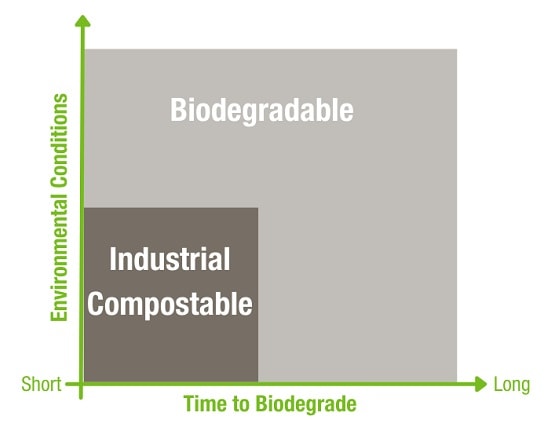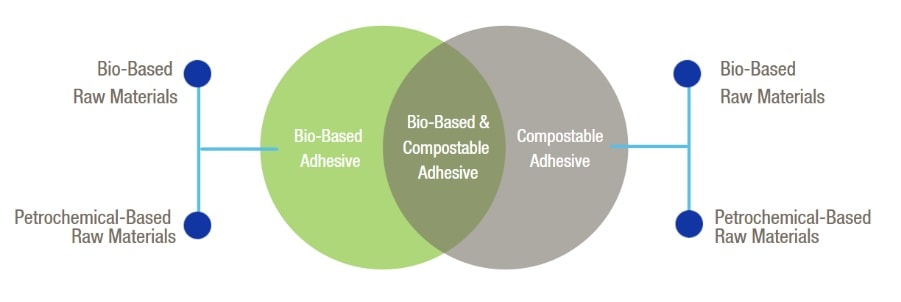
The Glue Talk Blog

Over the years, we have seen many trends arise within the hygiene market. Odor control for feminine hygiene, new adult incontinence solutions, softer construction materials and thinner cores in baby diapers are just a few of the innovations that have changed the hygiene market forever. There is a new frontier that is still on the horizon – the frontier of sustainability and the development of sustainable solutions in the absorbent article space.
According to Euromonitor, the third fastest growing megatrend in 2021 is the evolution of sustainable hygiene*. Around the world, consumers of disposable hygiene products are seeking out more environmentally-friendly products. Increasing environmental awareness of consumers, developments in regulatory compliance, and the popularization of the circular economy is driving the hygiene industry to improve the sustainability of its products and processes. We believe that this sustainability focus will continue to increase in the coming years into the next megatrend. H.B. Fuller is at the forefront of this emerging trend and is working hard to ensure that the right adhesive solutions are in place. Adhesives play a critical role in bonding multiple components of a hygiene article together and developing compatible solutions that can support your sustainability plan is our top priority.
As we learn more about this emerging space, we are seeing new words and claims that make it challenging to understand compliance. Terms like bio-based or industrial compostable have gained more and more attention in the hygiene market. Perhaps you are confused by these terms and are struggling to understand the difference. Perhaps you want to develop solutions for this space, but you aren’t sure which direction to go. Let’s take a deeper dive into the details of this terminology and see if we can increase your comfort level.

*Euromonitor, 2020, Evolution of Sustainable Hygiene
Bio-Based Adhesive
Biomass-based, optimized with materials sourced in nature
- Supports substitution of petrochemical components with bio-based and renewable raw materials
- Based largely on materials derived from natural sources, which can be replenished naturally with the passage of time
- Retains the strong bonding performance of the petrochemical counterparts across a wide range of substrates
Industrial Compostable Adhesive
Biomass-based, optimized with materials that can be composted under specific conditions
- Hot melt adhesives that can be broken down into a nutrient-rich substrate under specific rules, time frame and quality of the composting process
- Contains high levels of bio-based and renewable raw materials for the most efficient life cycle management
You might be wondering why we are using the term “industrial compostable” and not the term “biodegradable.” As consumers, we have been exposed to the term biodegradable when making product selections on the retail shelf. As it turns out, the term biodegradable can be a bit misleading. Everything eventually biodegrades, even if it takes thousands of years. For maximum effectiveness, the claim biodegradable should always come with an explanation of the surrounding environmental conditions under which a product or material biodegrades. When we use the term industrial compostable, we are specifying one type of biodegradation in very specific environmental conditions where the right level of heat, water and oxygen are facilitated to support the composting process. Take a look at the visual below. This shows that industrial compostable is a representative subset of the broader biodegradable designation.

Sustainable Packaging Coalition
As absorbent article designers, you also need to know that bio-based materials are not always compostable. The term “bio-based” only refers to the origin of the material. Unlike the term “compostable,” bio-based does not refer to the end of the life cycle. Let’s investigate this by looking at the diagram below.

The world is moving toward eco-oriented innovations. H.B. Fuller is dedicated to finding solutions to improve the environmental impact of products and making our planet a healthier and safer place. We have already launched innovations in the adhesive industry that have enabled environmental improvements. These innovations have supported a sustainability story by achieving significant reduction of the overall diaper thickness/weight or reducing the add-on or energy spent just producing the adhesives. While these innovations are helpful, they don’t go far enough. H.B. Fuller is ready to take innovation to the next level with bio-based and compostable solutions. And we want to partner with customers to help navigate this emerging space and achieve sustainability goals. Contact me to learn more.
*Understanding Sustainable Living Through Product Claims, Euromonitor International
Blog Categories
Blog Categories
Archive
- 2024
- 2023
- 2022
-
2021
- January (3)
-
February (7)
- Celebrating Exceptional Service During COVID-19 Complications
- Cyanoacrylates: What They Are and What They Do
- Innovative two-shot bookbinding adhesive
- Make a Difference 2020
- Problem Solving: Paper Straws in Drinking Beverages
- Stronger straws sustainable future
- Substances of Interest in Disposable Absorbent Hygiene Products
- March (4)
- April (4)
- May (4)
- June (5)
- July (2)
- August (5)
- September (2)
- October (1)
- November (3)
- December (2)
-
2020
- January (4)
- February (2)
- March (3)
- April (4)
- May (3)
-
June (7)
- Community Support in the Era of Coronavirus
- HBFuller Employee Creates Face Shields with 3D Printer
- Improved Packaging Integrity and Greater Customer Satisfaction
- Liquid-Resistant Paper Straws
- What is a Sealant?
- What Is the Future of Commercial Disinfectants?
- Winning over consumers with e-commerce packaging solutions
-
July (6)
- Employees Take Action to be Part of Healing and Growth
- Gain a competitive advantage with packaging adhesive solutions
- HB Fuller Company Foundations Commitment to Communities
- Packaging Solutions for the South African Agriculture Market
- Supporting Organizations That Provide STEM Education for Youth
- Where Does Sustainability Stand Amid COVID-19
- August (3)
- September (2)
- October (4)
- November (2)
- December (4)
